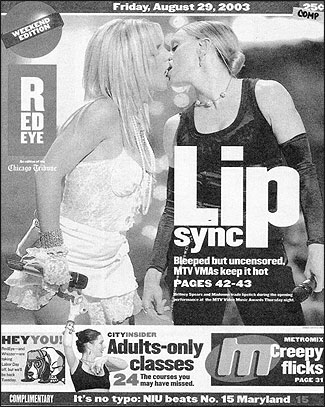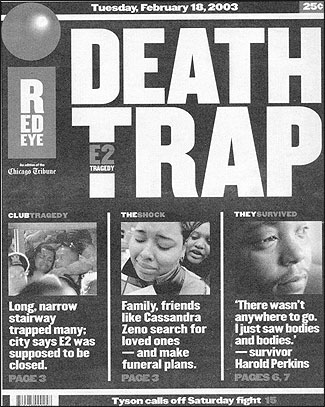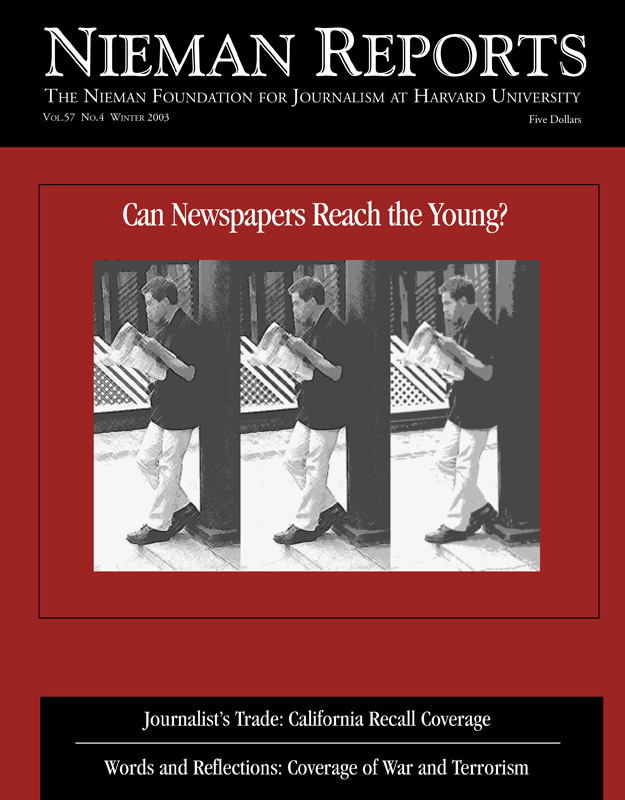Youth is not the only thing wasted on the young. Newspapers have squandered mountains of resources in attempts to capture the attention of young adults, but so far most of the effort has been in vain. Readership statistics among this coveted demographic group haven’t budged—except to move further downward.
This is troublesome to all of us ink-on-paper people, who don’t have to look far to see a future where the only people reading newspapers will be retirees. Rather than give up the fight, however, the Chicago Tribune decided to engage it head-on. The result, introduced in October 2002, is the RedEye, a tabloid edition aimed at young, urban commuters in Chicago. After learning of the Tribune’s decision to launch RedEye, the Chicago Sun-Times began working on a youth oriented paper of its own called Red Streak.
Thankfully there is still a robust market full of readers who want a full-service, full-size paper, and they are well served by world-class newsgathering organizations such as the Tribune. RedEye’s mission was not to give those readers a “Trib Lite” or a “Tribune on Training Wheels,” but rather to rethink the traditional newspaper and edit it in a way that it would be more attractive and compelling for these young nonnewspaper readers. There were some concerns that a new paper might cannibalize existing Tribune readers, but we were confident we could keep these losses small by making RedEye a much different publication than its older, more established sibling.
From these ideas, RedEye began to take shape: a smartly edited, general-interest newspaper that would be easy to consume on mass transit, a new breed of newspaper with its own distinct identity. Even the name had to say, “Look at me. I’m not like the other papers.”

A cover from the Chicago Tribune’s RedEye.
RedEye’s Look and Feel
RedEye’s visuals are bold, its stories are quick and to the point. There are no “Continued on page …” lines. In study after study, focus group after focus group, readers kept telling us they hated turning pages in midstory, especially while on a bus or train. Why not listen to them? If people have 20 minutes at most to spend with a paper on their way to or from work, why do so many papers still write and edit the news as if everyone is leisurely reading it in an easy chair?
To get attention in an increasingly cluttered landscape of media options, RedEye’s cover has a billboard format, designed for maximum impact in a street-sales environment. The back page isn’t sports, as it is in many tabloids, but instead is a destination space for the most buzz-worthy stories we can find. This way, you have something to read on the train even if you don’t have enough elbowroom to actually open the paper. Sports takes its place inside the book, serving as the bridge from the news to the features section. That feels natural. Sports, by definition, fall somewhere between reality and entertainment.
Celebrity and people news compete with “important” stories for prime display space in RedEye. Stories are judged on their relevance and the level of interest they are likely to create. If everyone is talking about Britney Spears kissing Madonna at the MTV Video Music Awards, the RedEye should be talking about it, too. Newspapers that ignore these types of stories are looking down upon their readers from a very shaky perch.
The stars of RedEye’s universe tend to be younger and more diverse—a reflection of our readers. In RedEye’s world, Jam Master Jay’s passing trumps Bob Hope’s. John Ritter vs. Johnny Cash? That turned out to be a decision we didn’t have to make because the two celebrities died on a day outside of our weekday publishing cycle. If we had to make the call, we’d have played the sitcom star over the music icon. Why? Ritter’s death was more unexpected, he was the star of a current show, and he meant more to a greater number of our readers, many of whom only knew Cash from his recent remake of a Nine Inch Nails song.

RedEye finds most of its readers on the subway.
Challenges Ahead for RedEye
Our approach to RedEye put off a lot of media critics, who quickly dismissed RedEye and said it was just “dumbing down” the news. They probably said much the same about USA Today or CNN’s Headline News, two other vehicles—and successful ones, I might add—for delivering information to people in a different format. It’s nice to know that as times and habits change at a frenetic rate, we can count on media criticism to be a dependable source of inertia and traditionalism.
The critics also chided RedEye for recycling Tribune content. Maybe they would have been happier if we used The Associated Press like most other papers like ours do. In any case, RedEye’s reliance on nonunique content has diminished as we’ve grown. No, we don’t have a Baghdad bureau yet, but we are producing a substantial amount of original local stories and features. RedEye has three—soon to be four—reporters covering the city, RedEye finds not to mention its own cadre of columnists, a fashion writer, a TV critic, and a movie critic who goes by the name of Mr. Cranky.
Still, it remains to be seen whether RedEye or any of its numerous imitators will win this campaign. Perhaps young people who have never been exposed to a daily newspaper habit within their households will never develop one on their own. I asked a young journalism student if she felt newspapers were an essential part of her daily routine, and her answer was telling. “I feel the need for information,” she said, “but I don’t feel the need for a newspaper.”
The biggest challenge remains getting people to simply make the effort to pick up a paper—any paper. When a RedEye lands in their lap, they’re happy enough to read it, even downright enthusiastic about it, but if they have to cross the street to find an honor box and then fumble for a quarter—well, that’s too much trouble, they tell us. They want the news, but they want it when they want it, where they want it, and how they want it.
RedEye wrestled with this dilemma when it came to defining what role our Web site (www.redeyechicago.com) should play. We knew young people had an affinity for electronically delivered news, but if we followed the dominant newspaper model and put all of our content online, how would that help us build a daily newspaper habit? We chose to make the site a “teaser,” with just a reproduction of the day’s cover and a few summaries of our best stories. This might not be the ultimate solution, but giving away valuable content for free in one format and asking people to pay for it in another didn’t seem like a viable long-term strategy, either. Most newspapers, the Tribune included, have adopted a free access model for reading the newspaper on its Web site, but if news organizations were to begin anew—as we were doing—I’m not sure they would make the same choice now that they did then.
This nexus of news delivery, in my opinion, is where the battle for future readers will be won or lost. Perhaps the newspaper subscription of the future is a bundled product: print, Internet and customized e-mail, to fit the changing needs and preferences of this new breed of consumer. This notion of “my news, my way” is why RedEye initiated a home delivery program last summer, even though it wasn’t part of the original business plan. We’d thought of street sales, but when some readers told us “just put it on our doorstep, and I’ll write you a check. Don’t ask me to make a decision everyday. Let me make one decision and be done,” we offered home delivery. The cost for five days delivery is a dollar each week (a 20 percent discount), and the Sunday Tribune can be included for another dollar (it normally costs $1.79 for home delivery). So far about 600 people have signed up for home delivery of RedEye.
Young people are also accustomed to getting much of their news free, or for next to nothing. RedEye’s circulation model is an adjustable mix of free and paid; currently the mix is about 90 percent free, 10 percent paid. Retail outlets and honor boxes are gradually being converted to paid-only, but we will continue to offer free papers indefinitely at certain transit stops and in places like college campuses where transactions can be difficult to conduct and where we want to be sure we reach our desired audience. The idea of an all-free paper was seriously considered in the beginning, but the company decided that the news and information we were providing had value and readers would recognize this and pay for it. Surprisingly, or maybe not surprisingly, advertisers have embraced RedEye more readily than readers. RedEye has picked up 250 new advertising accounts from clients who had never before been in a Tribune product. I’d like to think the ad folks are ahead of the curve, but more likely they’re just as desperate as newspapers are to reach new customers. Circulation numbers are inching upward, though not as quickly as we had hoped. We are, however, reaching our target audience effectively, based on Gallup Poll figures. And so far the only measurable cannibalizing of existing readers has come at the expense of our competition.
RedEye’s success won’t really be measurable for years. We won’t know for sure if this experiment worked until another upstart publication comes along to attract the next generation, the one that no longer finds the tired old RedEye relevant.
Joe Knowles is coeditor of RedEye. Before his work on RedEye, he was the Chicago Tribune’s design and graphics editor for two years and associate sports editor for 10 years.


